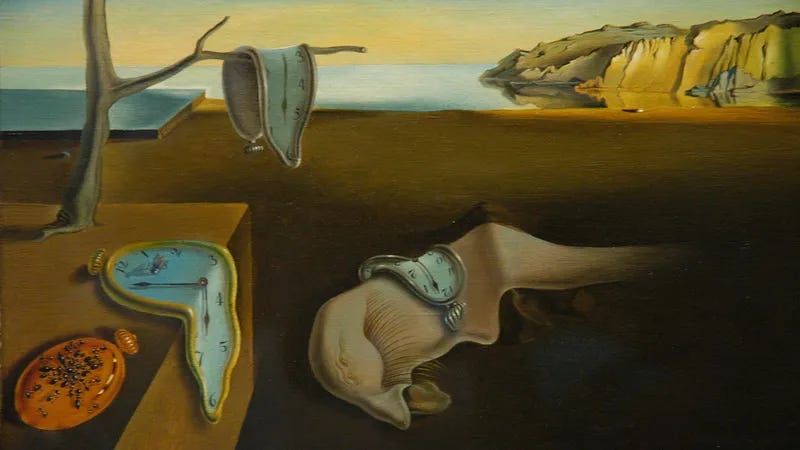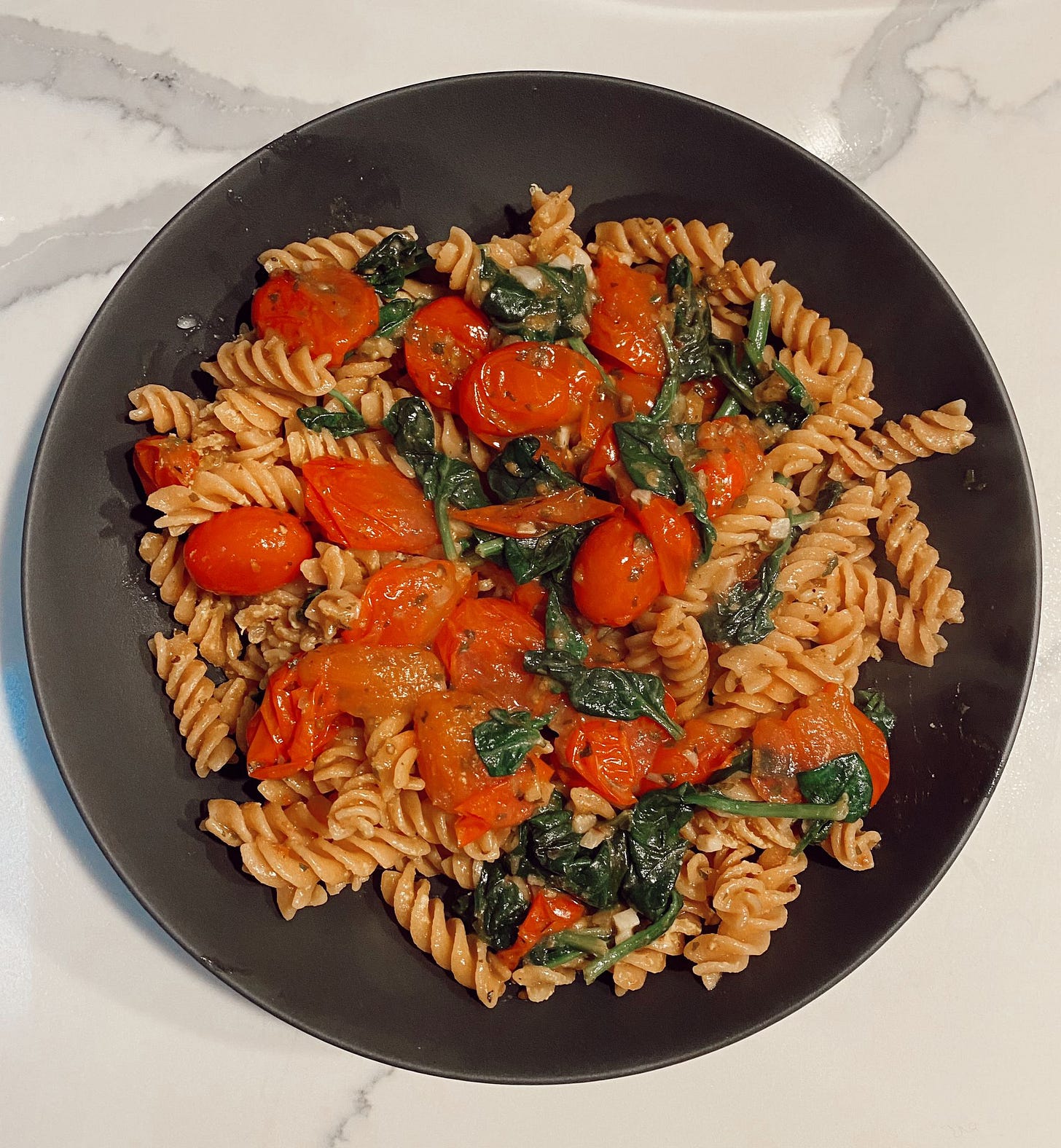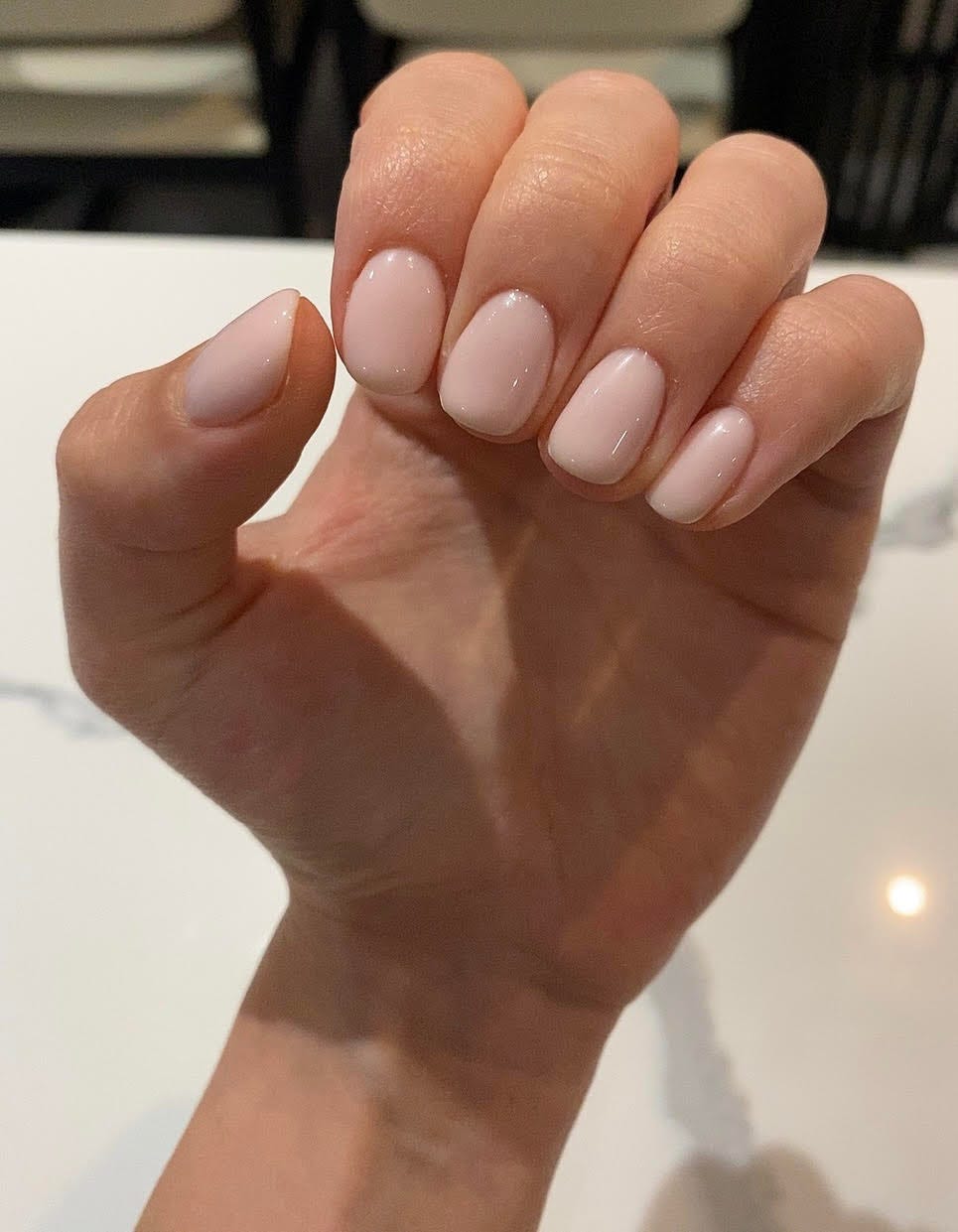Volume 9
The Persistence of Memory by Salvador Dalí — Protein pasta recipe — Nails — Taxi Driver by Martin Scorsese — Motherhood
Happy Sunday and welcome to the ninth edition of Giselle daydreams. In this volume, I’m discussing again a Surrealist artwork, but this time, I'm introducing a new artist, Salvador Dalí. I’ll also share a pasta recipe that I make on a weekly basis, what I do to keep my nails polished and healthy looking, and an iconic American thriller from the 1970s. Finally, you’ll also discover Queen L’s bath routine.
A painting
The Persistence of Memory by Salvador Dalí (1931)
Again, I am writing about a surrealist masterpiece, this time by Salvador Dalí, as I have always been fascinated by the thought provoking imagery conveyed by Surrealist artists.
The Persistence of Memory is a painting by the Spanish surrealist artist Salvador Dalí, completed in 1931. This iconic artwork depicts a dreamlike and bizarre imagery. Soft, melting clocks hang over tree branches and rest on a distorted face, as well as on a barren landscape, seemingly defying the conventional laws of time and space. The distorted and drooping clocks suggest a sense of timelessness and the fluidity of reality, which are common themes in Dalí's work.
Dalí's inspiration for this painting reportedly came from the theory of relativity, particularly the idea that time is not rigid and fixed but rather fluid and subjective. The melting clocks are often interpreted as a symbol of the relativity of time, suggesting that time is not constant and can be distorted or perceived differently in different circumstances.
The most striking feature of the painting is the melting clocks draped over various objects. These drooping, almost liquefied clocks defy the usual concept of time. They represent the fluidity of time and Dalí’s fascination with the idea that time is not rigid but rather subjective and malleable.
The background of the painting depicts a barren and desolate landscape, often identified as Dalí's hometown Figueres in Spain. The distorted cliffs and crumbling trees add to the dreamlike, surreal atmosphere. The dreamy quality of the landscape reinforces the idea that the painting is a depiction of a dream or a subconscious realm.
There is a distorted, almost monstrous face in the centre of the painting. Some interpretations suggest that this figure represents Dalí himself, with the drooping clocks symbolising his anxieties about mortality and the passage of time. Others view it as a symbolic representation of the persistence of memory, as memories can sometimes appear distorted or fragmented over time.
The painting features ants, which are commonly associated with decay and decomposition. In this context, they might symbolise the destructive effects of time. The ants are shown swarming on one of the melting clocks, underscoring the transient nature of even the most solid and enduring objects.
Dalí incorporates biological or organic shapes, resembling the human face and other forms, into the landscape. These forms blur the lines between living and inanimate objects, suggesting a dreamlike state where boundaries between different entities dissolve.
The Persistence of Memory is often seen as a visual representation of a dream. Dalí was greatly influenced by Sigmund Freud's psychoanalytic theories, and his work frequently explores the subconscious mind and dreams. The melting clocks and distorted imagery evoke the sense of timelessness and fluidity experienced in dreams.
The Persistence of Memory is a surrealistic masterpiece that challenges our perceptions of reality and time. It delves into the fluidity of memory, the subjectivity of time, and the dreamlike nature of our subconscious. Dalí's use of symbolism and distorted imagery creates a visually captivating and intellectually stimulating artwork that continues to captivate audiences around the world.
The Persistence of Memory is often interpreted as a meditation on the relativity of time and the fluidity of reality. Dalí himself described the clocks as "the tender, extravagant, solitary, paranoiac, critical camembert of time and space." The barren landscape in the background and the distorted face in the foreground add to the painting's surreal and mysterious atmosphere. The overall composition of the painting creates a sense of timelessness and a dreamlike quality, inviting viewers to contemplate the nature of reality and the passage of time. The painting has become an iconic image of the Surrealist movement and is widely recognised in popular culture. It is housed in the Museum of Modern Art (MoMA) where it continues to captivate viewers with its dreamlike and enigmatic quality.
A recipe
Vegan protein pasta
This dish is one of my favourites for a comforting lunch or dinner. I use red lentil pasta as it’s rich in protein and tastes similar to regular or wholewheat pasta. Even my husband who only wants white pasta thinks they taste good, therefore it means something!
To make one portion (you can easily double the quantity if you want to make more)
80-125g red lentil pasta depending on how hungry you are
1 pack (approx. 300g) of ripe baby plum tomatoes, don’t use cherry tomatoes, plum tomatoes are better for this recipe, or if you feel fancy use a mix of red and yellow plum tomatoes
sprinkle of chilli flakes
1 tbsp nutritional yeast
parsley, as much as you like
pink Himalayan salt and pepper to season
a handful of spinach (optional)
olive oil for frying
Instructions
Heat some oil in a frying pan on medium/low heat and place the plum tomatoes.
Meanwhile, cook the pasta as per the packaging instructions. You can add spinach if you like.
After a couple of minutes the tomatoes will become softer and juicier. You can gently squash them so it releases more juice and sweetness, this will make the sauce without the need of more olive oil or cream. Sprinkle the chilli flakes and parsley.
Once the pasta is cooked, drain and rinse it well. Make sure you squeeze the water if you added spinach, otherwise it will be soggy when you add the pasta to the tomato sauce.
Season with salt and pepper and mix well the pasta and the tomatoes. Finish by adding the nutritional yeast on top for a cheesy taste. It’s ready to eat. Enjoy!
Beauty
Let’s talk about nails
When it comes to nails, I have to say that I consider myself conservative and minimalist. You will not find me wearing an extravagant colour, nail art or ultra long nails. Instead, I like short polished nails in a nude shade or a thin French manicure. I feel lavish, I would opt for a warm red, but this rarely happens.
The fact that I prefer shorter nails is embedded in my childhood and teenage years as I used to play the violin, and I was not able to grow my nails. Even now, despite not playing the violin often, I kept this habit, and when I go for a manicure, I always ask for a short or mid length nails as after three weeks, I find them way too long.
In the past, I used to request a square shape with soft rounded edges. I loved that shape. Unfortunately, my nails kept breaking and I opted for an oval or round shape, and my nails would no longer break. The fact that my nails were breaking made me adamant to keep getting gel manicure as on top of that, they were peeling, and I found myself peeling off the gel (ouch) and removing at the same time the nail bed, which would take several weeks to regrow. During that time, I decided to let my nails breathe and get stronger again.
More recently, I decided to experiment this new technique - at least it is new to me, and opted for BIAB known as gel in a bottle, and I am thrilled I took the leap. The result looks amazing and I find I am nailing my manicure goals. I do it on my natural nails and I like their choice of light and nude colours. If you prefer darker shades, you can add a gel colour on top. I would also take breaks after a few manicures, and if you keep doing BIAB, I would do infill and manicure but not soaking to remove the entire process. My recommendation is to go for BIAB if you have brittle and weak nails and want to keep your natural nails healthier without having to redo your regular polish every couple of days.
A film
Taxi Driver by Martin Scorsese (1976)
When I was in high school, between the age of 15-18 years old, I became interested in widening by knowledge thought-provoking films. I watched many films several times, as I was absorbed with the cinematography, the plot, the cast, the decor and costumes, the music, and every component of what makes a film a cinematic masterpiece. Taxi Driver was one them.
Taxi Driver is an American neo-noir psychological thriller film directed by Martin Scorsese and written by Paul Schrader. The film stars Robert De Niro as Travis Bickle, a mentally unstable Vietnam War veteran who works as a night-time taxi driver in New York City.
Travis Bickle, a lonely and disturbed Vietnam War veteran, becomes a taxi driver in New York City. Suffering from insomnia, he becomes increasingly disconnected from society and descends into madness. Travis becomes infatuated with Betsy, played Cybill Shepherd, a woman working on a presidential campaign, and befriends a young prostitute named Iris, played by Jodie Foster. Travis's deteriorating mental state leads him to contemplate violent acts, ultimately culminating in a shocking and violent confrontation.
Travis Bickle's character embodies the isolation and alienation prevalent in urban life. He struggles with deep loneliness and disconnect from the world around him, highlighting the dehumanising effects of the city.
Taxi Driver presents a gritty and grimy portrayal of the 1970s New York City, showcasing its decay, crime, and moral ambiguity. Scorsese captures the city's underbelly, creating a haunting backdrop that mirrors Travis's mental state.
The film explores the intersection of violence and mental illness, depicting Travis's descent into madness and his violent tendencies. It raises questions about the influence of environment and psychological factors on a person's behaviour.
Travis's relationships with Betsy and Iris highlight themes of sexual exploitation and the desire for redemption. His attempts to save Iris from her life as a prostitute reflect his distorted sense of morality and his desperate need to make a meaningful connection.
Scorsese's direction, coupled with Paul Schrader's screenplay, employs innovative storytelling techniques, including voice-over narration and a surreal, dreamlike quality. The film's cinematography and use of colour contribute to its unsettling atmosphere, emphasising Travis's psychological turmoil.
Taxi Driver received critical acclaim upon its release and has since become a cultural touchstone. The film's iconic line, "You talkin' to me?" delivered by De Niro, has become one of the most famous quotes in cinematic history.
Taxi Driver remains a significant work in Martin Scorsese's filmography and is often cited as one of the greatest films ever made. Its exploration of urban alienation, violence, and psychological distress continues to resonate with audiences and scholars, making it a classic in the realm of American cinema.
Motherhood
Queen L bath routine
Moving on from Taxi Driver to something lighter and fresher, let’s talk about what I use when I bathe Lior a few times a week. Some people bathe their babies daily. Personally, I don’t do that yet, except when we were in extreme heat during our summer holidays, as Queen L loves spending ages in the water and becomes extremely upset if I cut short her bathing moment.
I think that something useful if you don’t want to bathe with your baby is to buy a baby bath. I chose this baby bath, as it responded to what I was looking for the first few months. There are other options, but if you have a small baby, this one is perfect.
In the beginning, I was using a wet bamboo cloth to put on Lior’s belly to make sure she wasn’t getting cold, but as the months went on, I stopped using it as she didn’t mind no longer having it at the start of her bath.
Something useful and not expensive is to get a thermometer. This way, the temperature is appropriate for your baby. I know that if I were to check it on my wrist, it would be too hot as I love my sorching showers.
I remember finding this adorable waterfall rinser while looking at baby bath items. Of course I couldn’t resist and had to buy it. I find it enjoyable to keep pouring warm water on Lior, and she loves it. It also comes handy when I need to rinse her hair.
I bought this baby hair comb which comes along a baby hair comb and a baby wooden brush with soft goat bristle. This is a mindful purchase, as you can use when your baby becomes a toddler as well.
A few months ago, I started massaging Lior and doing baby massage classes. I decided to introduce coconut oil to help massage my little doll and keep her skin moisturised. I purchased Childs’ Farm baby oil. I think you could use regular coconut oil, but I like that this one is already in its liquid form and ready to use. It’s also 75ml, which is also practical when travelling.
When I was researching which baby products to buy, I was drawn to Weleda as I previously used their products in the past. I bought the Weleda hair and body shampoo that I still use to this day, and it also doesn’t irritate your little one’s eyes, which is a necessity if you have an agitated baby during bath time and thinks that the more you splash water, the better it is.
I like this Weleda body lotion, but I also bought the baby oil , which I haven’t used yet, as I want to finish the lotion and the coconut oil before opening a new product. I’m not a big fan of the lotion and its texture. It works alright, but I wouldn’t purchase it again.
Queen L is definitely a mummy’s girl as she loves her skincare pampering moment. I use daily the Weleda face cream, and she smiles at me while I gently massage her chubby cheeks. For some reasons, I prefer not to use coconut oil on her face, but this is a personal choice. This cream hasn’t given her any irritations yet. Therefore, I think it’s perfect for her, and I don’t attend to change this product from her routine.
Finally, you need hooded towels. Something nice is to get them as gift from people. If you choose to have a baby registry, don’t forget to include a few designs you like. Something you need to learn, is you always need spares when you have a baby!
I hope you enjoyed the ninth edition of Giselle daydreams.
Giselle xx








As a good friend of yours, can I request a narration on the meaning behind René Magritte's 'The Son of Man' in your next daydream?